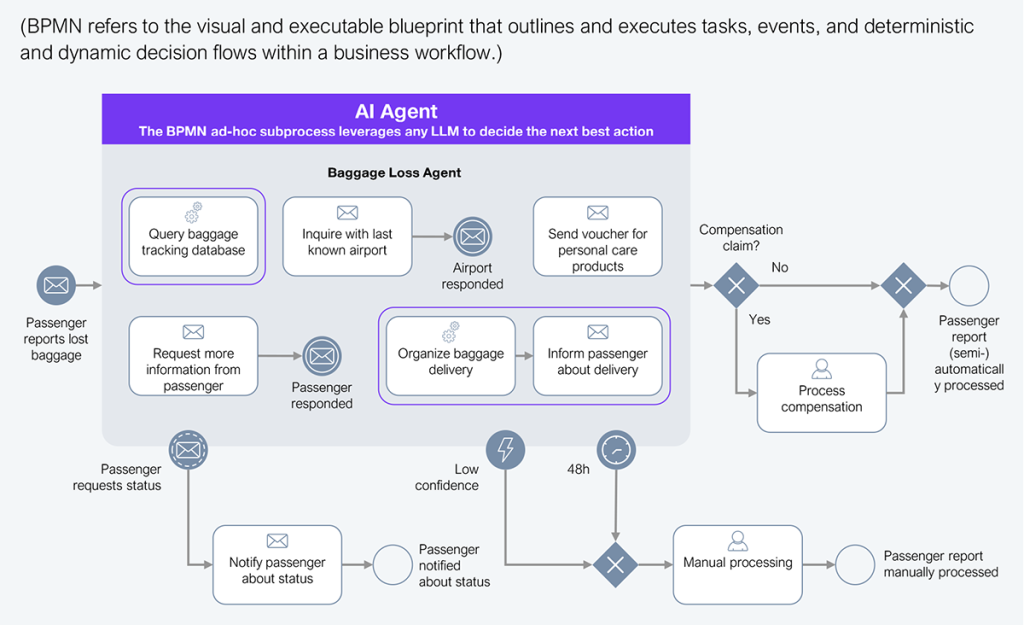Decades of technical and process debt mean static and semi-flexible workflows often deliver limited outcomes in today’s unpredictable environment. This is why enterprises are under growing pressure to operationalize AI within their workflows—typically easier said than done. Camunda, a 600-client strong player in the business process management (BPM) market, with a strong growth record, recognized this and has come to market with its iteration of agentic orchestration to make enterprises’ AI vision a reality. It is also shifting its internal needle to meet shifting enterprise demands.
HFS analysts recently connected with Camunda’s leaders, partners, and clients at CamundaCon to learn if its agentic orchestration offering is truly differentiated, and if the new-look Camunda will resonate with enterprises.
Traditional process orchestration falls into two categories: deterministic (strictly defined workflows where every step and outcome is pre-determined) and dynamic (introduces flexibility, but outcomes are still based on a handful of pre-determined options). These models have their limitations, which Camunda hopes to address by introducing AI agents that go beyond pre-configured decisions to interpret context, make decisions, and coordinate across various enterprise systems. They call this agentic orchestration. Agentic orchestration is offered in addition to Camunda’s traditional process orchestration offerings, meaning enterprises can choose to leverage Camunda with or without AI. The new approach allows enterprises to embed agents in a process to act autonomously and make real-time decisions based on changing circumstances and data (see Exhibit 1).

Source: Camunda, 2025
It’s important to note that Camunda is not unique in doing this—large players are baking their iterations of agentic orchestration into their offerings. But while these often require enterprises to participate in larger ecosystems, Camunda differentiates itself by integrating across a spectrum of tools, such as ServiceNow, through APIs and connectors. This does require investment to configure properly, but these integrations can be added inside or outside the AI agent, giving enterprises more flexibility. For example, embedding integrations inside agents will allow autonomy and speed, while outside will drive transparency and governance.
Camunda looks to differentiate itself in how it addresses enterprise concerns around AI compliance and oversight. By embedding AI agents as a subprocess in its traditional deterministic and dynamic models, as shown in Exhibit 1, it can only operate within clearly defined boundaries and trigger human intervention if the scope of its task demands anything further. While many enterprise leaders remain understandably cautious about deploying agents within their business, baking agentic orchestration within existing models should give them the confidence to realize their aspirations.
Throughout the event, Camunda articulated the value of agentic orchestration through live demos with real stories directly from the clients and partners. Lars Tandrup from EY, one of Camunda’s partners, explained how a global bank was exploring how it could leverage AI. Rather than a small incremental approach, they tackled a high-impact repetitive process—T+1 settlements. This refers to a regulation that dictates that securities trades must be settled within a single business day, meaning capital and assets must be exchanged within 24 hours, or they face significant financial penalties.
The bank employs almost 5,000 people to do this, and each employee is expected to analyze five to 10 cases daily. Despite this, it paid approximately $9 million in penalties over the last year. EY built a solution leveraging Camunda’s agentic orchestration capabilities to introduce AI agents to review and clear trades, while escalating exceptions or complex cases for human analysis.
Within 10 weeks, the solution was developed and piloted in a small user group within the bank. Lars advised that they reported a 700% increase in cases each employee could handle and a 98% reduction in cases exceeding the 24-hour deadline. This proves that Camunda’s agentic orchestration can deliver significant business value— in this instance, millions of dollars in savings, if deployed correctly.
We’re living through unprecedented change, and the way enterprises buy technology is changing with it, as the percentage of technology budget held by business leaders (versus IT) is growing significantly. For enterprises, that might mean Camunda is new to speaking your language, given that much of Camunda’s success has come from a technology-led go-to-market. This heritage was evident at CamundaCon as the event was packed with demos and technical features.
However, Camunda is strategically pivoting to engage more actively with business leaders. For savvy enterprises, this means Camunda could bridge the gap between business outcomes and technical execution. Still, you need to bring both sides to the table to make it a reality. On its part, Camunda must ensure it can effectively translate technical details into business impact if it hopes to resonate with its new target audience.
Aligning business and IT leaders rarely happens alone, which is why Camunda is also investing heavily in expanding its partner ecosystem. In fact, Camunda’s leadership advises a significant growth in the number of partner-sourced bookings in 2025 compared to the previous year. This opens new pathways for enterprises to engage with Camunda through SIs that already have a deep understanding of their business, its challenges, and how to communicate effectively with their leaders.
If you’re under pressure to drive AI adoption within your organization, agentic orchestration could be a good way to make it a reality. Camunda is a fast-growing vendor that could be a valuable partner given its recent technological and strategic pivots. But no growth comes without growing pains, and as Camunda looks to shift its needle from IT to Business leaders while continuing to scale, enterprises must be wary of the challenges this might bring, particularly around Camunda’s ability to articulate business value beyond its strong technical foundation.
Register now for immediate access of HFS' research, data and forward looking trends.
Get StartedIf you don't have an account, Register here |
Register now for immediate access of HFS' research, data and forward looking trends.
Get Started